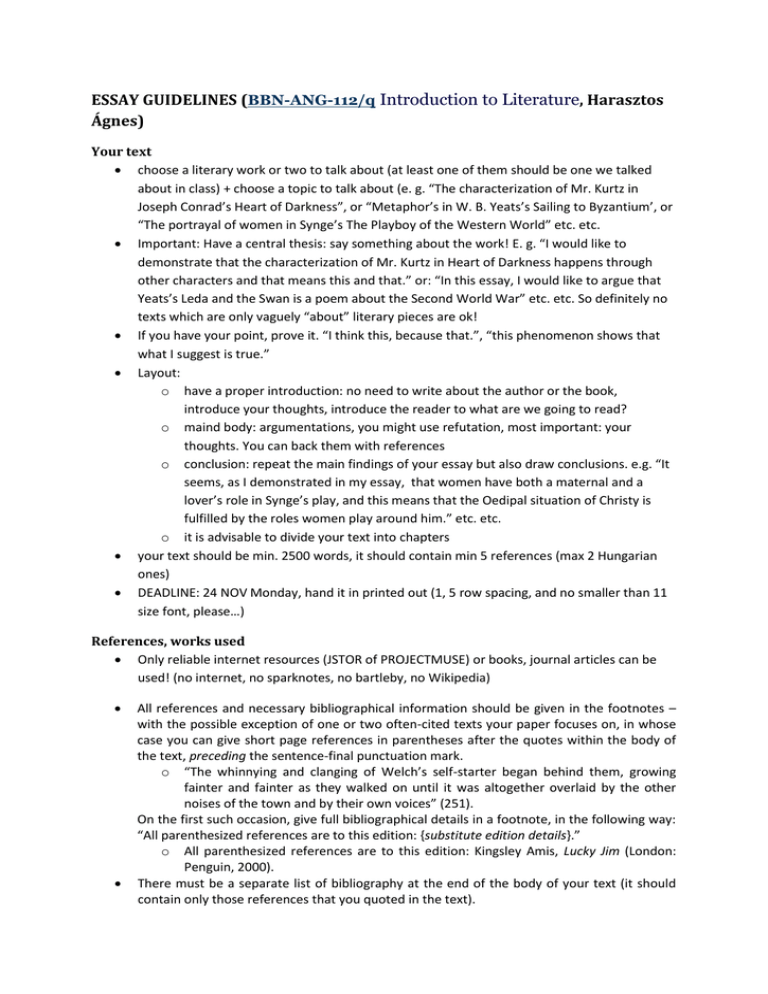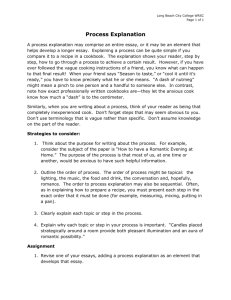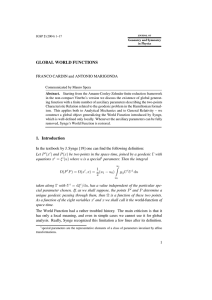Essay guidelines
advertisement

ESSAY GUIDELINES (BBN-ANG-112/q Introduction to Literature, Harasztos
Ágnes)
Your text
choose a literary work or two to talk about (at least one of them should be one we talked
about in class) + choose a topic to talk about (e. g. “The characterization of Mr. Kurtz in
Joseph Conrad’s Heart of Darkness”, or “Metaphor’s in W. B. Yeats’s Sailing to Byzantium’, or
“The portrayal of women in Synge’s The Playboy of the Western World” etc. etc.
Important: Have a central thesis: say something about the work! E. g. “I would like to
demonstrate that the characterization of Mr. Kurtz in Heart of Darkness happens through
other characters and that means this and that.” or: “In this essay, I would like to argue that
Yeats’s Leda and the Swan is a poem about the Second World War” etc. etc. So definitely no
texts which are only vaguely “about” literary pieces are ok!
If you have your point, prove it. “I think this, because that.”, “this phenomenon shows that
what I suggest is true.”
Layout:
o have a proper introduction: no need to write about the author or the book,
introduce your thoughts, introduce the reader to what are we going to read?
o maind body: argumentations, you might use refutation, most important: your
thoughts. You can back them with references
o conclusion: repeat the main findings of your essay but also draw conclusions. e.g. “It
seems, as I demonstrated in my essay, that women have both a maternal and a
lover’s role in Synge’s play, and this means that the Oedipal situation of Christy is
fulfilled by the roles women play around him.” etc. etc.
o it is advisable to divide your text into chapters
your text should be min. 2500 words, it should contain min 5 references (max 2 Hungarian
ones)
DEADLINE: 24 NOV Monday, hand it in printed out (1, 5 row spacing, and no smaller than 11
size font, please…)
References, works used
Only reliable internet resources (JSTOR of PROJECTMUSE) or books, journal articles can be
used! (no internet, no sparknotes, no bartleby, no Wikipedia)
All references and necessary bibliographical information should be given in the footnotes –
with the possible exception of one or two often-cited texts your paper focuses on, in whose
case you can give short page references in parentheses after the quotes within the body of
the text, preceding the sentence-final punctuation mark.
o “The whinnying and clanging of Welch’s self-starter began behind them, growing
fainter and fainter as they walked on until it was altogether overlaid by the other
noises of the town and by their own voices” (251).
On the first such occasion, give full bibliographical details in a footnote, in the following way:
“All parenthesized references are to this edition: {substitute edition details}.”
o All parenthesized references are to this edition: Kingsley Amis, Lucky Jim (London:
Penguin, 2000).
There must be a separate list of bibliography at the end of the body of your text (it should
contain only those references that you quoted in the text).
Footnote numbers in the text are to be placed directly after the punctuation marks.
o Melville consciously refrained from calling Pierre a novel.12
o Maybe Joyce also shared or at least had a premonition of the astronomers’ doubts
about the origin of Pluto?47
o “The ocean is the bondless truth and land is the threatening reef of human error.”34
Please use the word processor’s automatic footnote function.
Always use double inverted commas, single only in the case of an embedded quotation.
o “Books, as Frye asserts, are ‘rubbish.’ ”
Commas and periods always precede the closing inverted comma/quotation mark; colons
and semi-colons always follow it.
In elliptical structures, use “. . .” rather than “[…]” or “…”
Common abbreviations are to be spelt as follows: cf., i.e., e.g., et al., etc.
The “hyphen minus” symbol (-) is to be used only in case of hyphenated compounds (e.g.
dark-haired).
Between page numbers and years use the “en dash” symbol (–) without leaving spaces
before or after it (e.g. pp. 23–25).
The dash (gondolatjel) is also marked by the “en dash” symbol. In this case, however, leave a
space before as well as after the dash.
o “Foaled in 1874, she won fifty-four out of fifty-four races in Hungary, Austria,
Germany, France and Britain – an achievement good enough for inclusion in The
Guinness Book of Records as well.”
Form of citation:
o John Smith, Title of Book (Place: Publisher, 1948). e. g. F.R. Leavis, The Great
Tradition: George Eliot, Henry James, Joseph Conrad (London: Chatto & Windus,
1948).
o John Smith, “Title of Paper or Short Thing,” Journal 11.2 (1977) 782–94. e. g. Chinua
Achebe, “An Image of Africa,” Massachusetts Review 18.4 (1977) 782–794.
o John Smith, “Title of Poem,” in Title of the Collection, ed. Thomas King, 5th ed.,
(Place: Publisher, 1998), vol. 2, p. 1133. e. g. Robert Frost, “Stopping by Woods on a
Snowy Evening,” in The Norton Anthology of American Literature, ed. Nina Baym, 5th
ed., (New York & London: Norton, 1998), vol. 2, p. 1133.
o John Smith, “Title of Paper,” Name of Web Page, accessed 8 December 2012
<http://wwww.nameofwebpage.com/etcetera.html>. e. g. Philip V. Allingham,
“Dickens’s ‘Hunted Down’ (1859): A First-Person Narrative of Poisoning and LifeInsurance Fraud Influenced by Wilkie Collins,” Victorian Web, accessed 8 December
2012 <http://www.victorianweb.org/authors/dickens/pva/pva19.html>.



